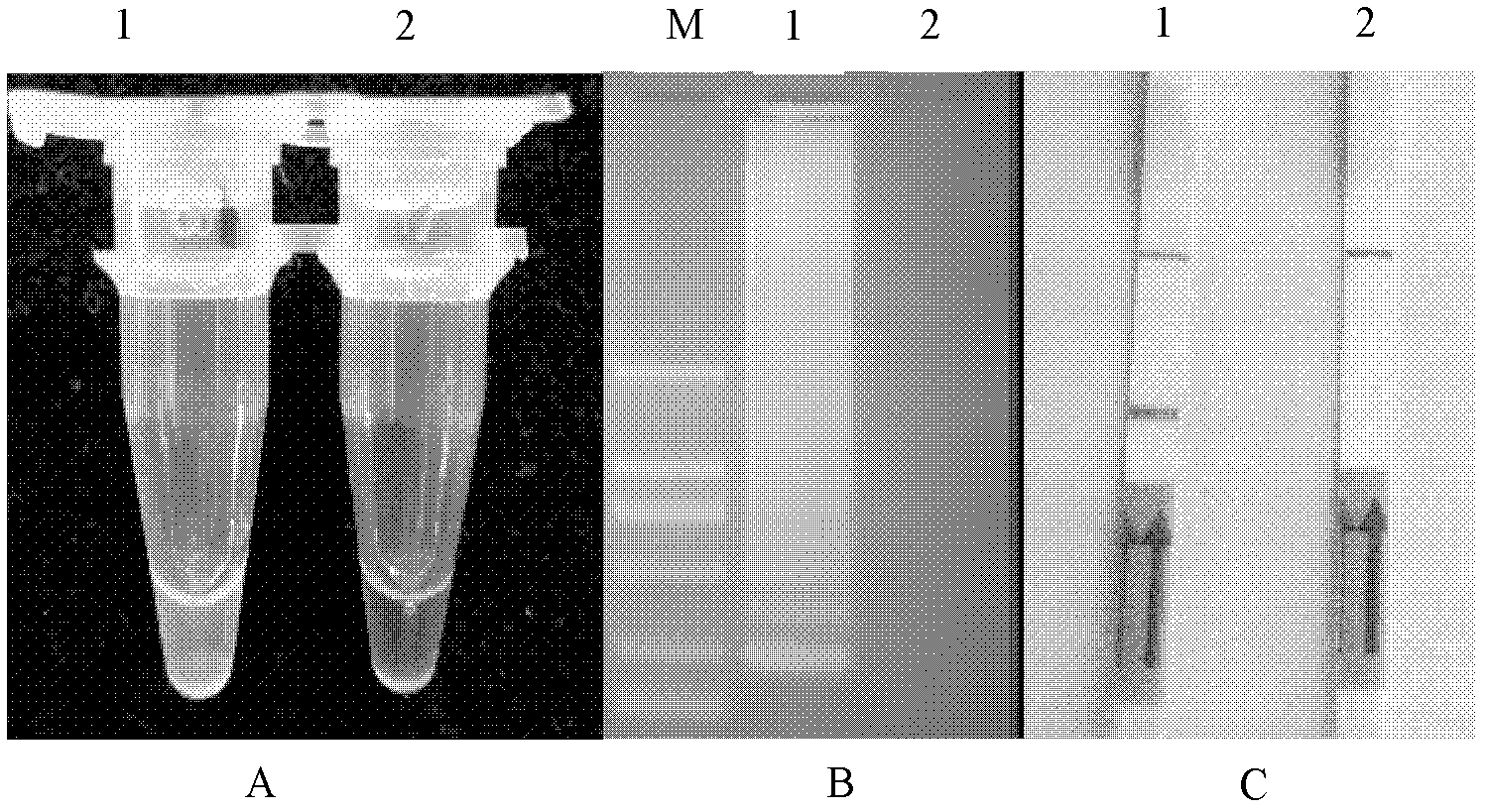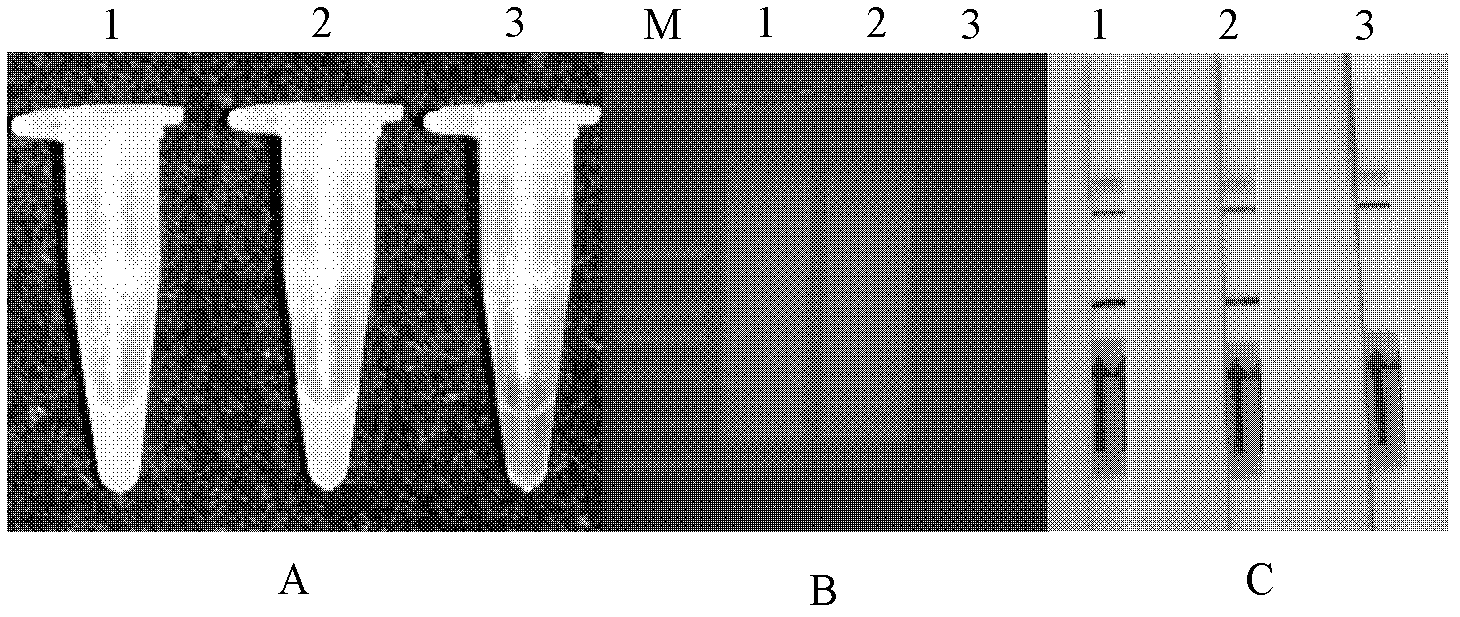Loop mediated isothermal amplification (LAMP) detection method for meloidogyne hapla and application of method
A detection method and technology for root-knot nematodes, which are applied in the directions of biochemical equipment and methods, microbial determination/inspection, etc., can solve the problems of limiting the popularization and application of PCR detection methods, long time, etc., and achieve short detection time, simple operation steps, Simple to use effects
- Summary
- Abstract
- Description
- Claims
- Application Information
AI Technical Summary
Problems solved by technology
Method used
Image
Examples
Embodiment 1
[0087] Example 1 Extraction, rDNA-ITS amplification and sequence analysis of the root-knot nematode DNA of northern root-knot nematode
[0088] 1.1 Extraction of DNA from M. northernis
[0089] Pick a single-headed root-knot nematode and put it in a container containing 10μdddH 2 Add 8 μl of WLB solution and 2 μl of proteinase K solution to a 0.2ml centrifuge tube of O, centrifuge in a jog, put it into liquid nitrogen, then put it into a 37°C water bath, put it into liquid nitrogen after it melts, repeat 6 ~7 times, and then frozen at -80°C for 30min. Then the centrifuge tube was taken out, incubated at 65° C. for 90 minutes, and reacted at 95° C. for 10 minutes. After treatment, it was directly used as a nematode DNA template for LAMP and PCR reactions.
[0090] 1.2 Amplification and sequence analysis of rDNA-ITS of M. borealis
[0091] The general primers rDNA1 (5'-TTGATTACGTCCCTGCCCTTT-3') and rDNA2 (5'-TTTCACTCGCCGTTACTAAGG-3') of the ITS region were used to amplify the...
Embodiment 2
[0092] Embodiment 2LAMP technology detects the establishment of the method for root-knot nematode borealis
[0093] 2.1 LAMP primer design
[0094] According to the sequencing results of M. northernis ITS sequence, design and screen the following LAMP primers and probes (such as figure 1 shown), the five primers include two outer primers (F3 and B3), two inner primers (FIP and BIP) and one loop primer (MELB), FIP consists of F1c-F2, BIP consists of B1c-B2, F1c and B1c are the complementary sequences of F1 and B1, respectively. Primers and probes were handed over to Shanghai Bioengineering Technology Service Co., Ltd. for synthetic labeling. The sequence is as follows:
[0095] ①MHF3: 5’-GAATATGAGGTGACATGTTAGG-3’
[0096] ②MHB3: 5'-TCAATGTTTCTGCAGTTCG-3'
[0097] ③MHFIP: 5’-TGAAAAAAATATTGCTGGCGTCCACCTAATCGGGTTTAAG
[0098] ACT-3'
[0099] ④ MHBIP: 5’-TCTATCCTTATCGGTGGATCACTCCACAAATTATCGCAGTT
[0100] AGCT-3'
[0101] ⑤ MHLB: 5'-GGCTCGTGGATCCATGAAGAACG-3'
[0102] ⑥MH-...
Embodiment 3
[0108] Embodiment 3 LAMP method detects different geographic populations of root-knot nematode
[0109] Two kinds of root-knot nematodes collected in our laboratory were tested by LAMP. After mixing the primer mixture and the reaction buffer mixture evenly, add 1 μl of template DNA, and proceed according to the reaction conditions in 2.3. After the reaction, add 2 μl of prepared color After the agent is mixed, observe the color change (such as image 3 Shown in A), green fluorescence can be seen in the tube with the DNA of M. northernis, and the negative control is reddish brown. Get 2 μ l of the product and electrophoresis on 2% agarose gel, stain with EB, observe and take pictures under ultraviolet light (such as image 3 Shown in B), the characteristic ladder-shaped band of LAMP can be seen in the 1-2 swimming lanes, and the negative control has no amplification product. 5 μL of FITC-labeled probe was added to the reaction product, incubated at 63° C. for 5 min, and coole...
PUM
 Login to View More
Login to View More Abstract
Description
Claims
Application Information
 Login to View More
Login to View More - R&D
- Intellectual Property
- Life Sciences
- Materials
- Tech Scout
- Unparalleled Data Quality
- Higher Quality Content
- 60% Fewer Hallucinations
Browse by: Latest US Patents, China's latest patents, Technical Efficacy Thesaurus, Application Domain, Technology Topic, Popular Technical Reports.
© 2025 PatSnap. All rights reserved.Legal|Privacy policy|Modern Slavery Act Transparency Statement|Sitemap|About US| Contact US: help@patsnap.com



